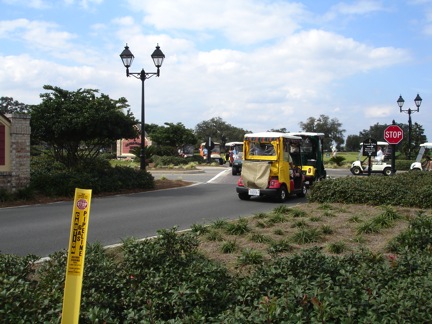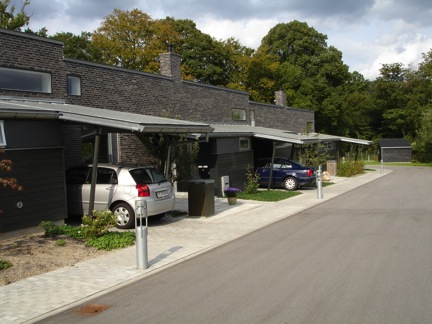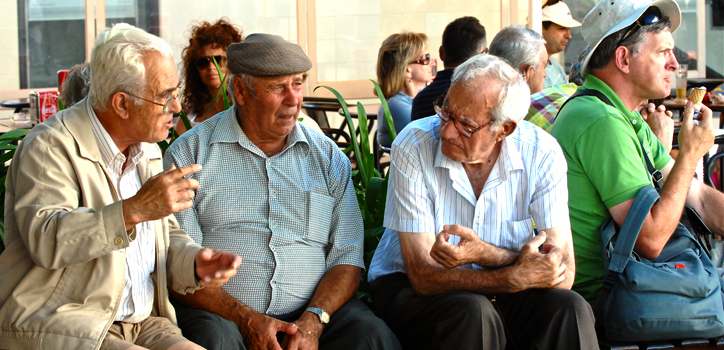Time to Think Differently
By Edward Steinfeld, AIA, Arch.D., Director, IDeA Center, University at Buffalo, SUNY
In this installment in our design for aging guest writers series, Edward Steinfeld, AIA, Arch.D., discusses the need to practice “community design for aging”.
Since the 1960s, there has been a steady increase in the development of environments built specifically for older people including retirement housing, continuing care retirement communities (CCRCs), memory care centers, and assisted living facilities. This occurred because economic development made long life more common. But while this demographic shift was occurring, enormous growth in suburban sprawl created low-density communities, and health care for elders evolved into a facility-based model. Now, the only places designed to accommodate old age are specialized facilities and neighborhoods separated from the rest of the population. Is this a new form of segregation? Does it reflect “ageism” in American society?
Perhaps the best example of this segregation is The Villages, an age-restricted community north of Orlando where 75,000 people have settled. On one hand, The Villages demonstrates that communities designed to be age friendly will attract older residents. On the other hand, The Villages and smaller versions of retirement meccas offer a disturbing vision of the future. Unlike government entities, they do not have a representative government; they are privately owned, modern versions of company towns. When residents commit to living in such communities, they give up a measure of autonomy and control and become “consumers” of services rather than citizens of a community and all that implies.

Golf cart traffic jam at The Villages
What would happen if even larger numbers of affluent elders picked up and moved to communities like The Villages—that is self-contained “active living communities” and CCRCs on the fringes of traditional towns and cities—leaving behind those with lower incomes and poorer health? Active older people contribute greatly to our society as productive workers, volunteers, caregivers (for both other elders and youth) taxpayers, and jurors. Their collective wisdom is a valuable resource for communities. As the population ages, we cannot afford to have too many withdraw from being citizens of traditional communities, especially if they leave the burden of caring for all those in great need to the rest us. Furthermore, the architecture that results is formula driven with an emphasis on the short term.
There is evidence that there is latent desire for other options. The surveys done on preferences for housing in old age indicate that substantial majority of middle-aged people want to “age in place” (see for example, Keenan, 2010). Demonstrating this preference, urban areas are attracting residents in their 50s because they provide walkable, mixed-use living opportunities that are more amenable to aging in place (Karp, 2008). In addition, the high cost of long-term care and the general dislike of institutional living is driving a renewed interest in home care and innovative methods for delivering care to elders who do not require relocation to a geriatric facility.
While demand for age-restricted settings may continue to be strong for some groups in the older population simply due to the rapidly increasing numbers of elders, a major focus for “design for aging” should be on rethinking existing communities in response to the maturation of society. We need to start planning and designing communities that will keep elders engaged in productive life, provide affordable housing options, insure safety and security, offer attractive leisure time pursuits, encourage diverse social opportunities, and support age related changes in abilities and health. We need to practice community design for aging. The Atlanta Regional Commission’s (ARC) Lifelong Community Design Initiative, featured in another article on this website, is one of the first efforts to really look at how to redesign existing communities and serves as a good model.
How do we transfer the knowledge about design for aging to this much larger and more complex problem? I believe the answer is by practicing universal design. Many design professionals think universal design is a new buzzword for accessible design or ADA compliance. Earlier definitions and publications about the concept did not help to overcome this perception because they were too focused on design to support function. But it is actually a radically different concept. Universal design applies all the lessons learned over the last 50 years about human-centered design to all environments, products, and services. It is not the province of technical specialists or experts in a specialized building type.
“Universal design is a process that enables and empowers a diverse population by improving human performance, health and wellness, and social participation.” (Steinfeld and Maisel, 2012). In other words, universal design is design for universal benefits, including, but not limited to, benefits for elders. In addition to compensating for deficits in function like accessibility in housing, it includes reducing health threats like air and water pollution, encouraging walking by building sidewalks and safer street crossings, and promoting social participation like providing opportunities for intergenerational social contact.
Designing settings for elders alone leads to socially unsustainable communities. For example, there are limited opportunities for a retiree to find a part time job in The Villages. One resident, a retired professional musician, confided to the author that there were so many amateur musicians willing to do gigs for free that he could not find enough paid work to keep himself busy. As a professional, he felt that his skills were not valued if people were not willing to pay him for performing. What will happen when most residents of The Villages reach their 80s and 90s? Who will provide health care? Who will play golf? Who will shop in the stores?
Design for diversity makes sense, even in the context of aging. People age at different rates along several dimensions at once, based on their biology, life experiences, personality, and social interaction style. We all are familiar with this phenomenon. At my university there is a 92-year-old professor who is still teaching a class while many of our much younger colleagues retired in their mid 60s or earlier for health reasons or to pursue other interests. These individual differences make the older population one of the most diverse segments of society. Yet places like The Villages, assisted living facilities, and CCRCs offer limited lifestyle choices. For example, almost all the homes in The Villages are single-family detached dwellings on cul-de-sacs. Practically everyone gets around by car or golf cart. Although there are interesting places to walk and congregate, getting to them requires a vehicle.
So, where do we start? Basically, we need to get stakeholders involved in community planning and design to think in universal design terms so that everything they do offers potential for the older generations. This is a process of innovation because it is a new way of thinking. The best way to spread an innovation is through personal contacts in a peer network. If you want to get a doctor to adopt digital record keeping, for example, convince another doctor she respects to adopt it first. Early adopters who are respected by their peers spread the innovation (Rogers, 2003). Organizations like the American Architectural Foundation and the AIA Knowledge Community on Aging can serve as change agents to recruit early adopters, not just in the architectural community, but also in the communities of clients and government.
A second important factor in innovation diffusion is clarifying the concept. To this end, my colleagues at the IDeA Center and I developed eight Goals of Universal Design to accompany the definition above. Each goal corresponds to a measurable outcome and a knowledge base from research:
- Body fit—accommodating a wide range of body sizes and abilities;
- Comfort—keeping demands within desirable limits of body function and perception;
- Awareness—insuring that critical information for use is easily perceived;
- Understanding—making methods of operation and use intuitive, clear, and unambiguous;
- Wellness—contributing to health promotion, avoidance of disease, and prevention of injury;
- Social integration—treating all groups with dignity and respect;
- Personalization—incorporating opportunities for choice and the expression of individual preferences; and,
- Appropriateness—respecting and reinforcing cultural values and the social and environmental context of any design project.
Universal design is not just focused on products. For example, “service design” can play an important role in implementing universal design by integrating the virtual with the physical worlds (Service Design Network, 2013). The success of Apple rests on the service design approach. The iTunes Store facilitates purchasing and installing new products. The use of similar interfaces on computers, phones, and tablets simplifies use of different devices. The “bento box” format of individual apps with colorful icons is appealing, flexible, and easy to remember and personalize. The integration of accessibility features like gesture-based touch interfaces and voice output/input not only broadened the market to elders with disabilities, but also exposed other users to these enabling technologies. The incorporation of FaceTime and free calls and messaging with other iPhone users provided affordable and satisfying ways to interact with family and share experiences in real time. It is no accident that the iPhone and iPad have become very popular with elders to the point where competitors are trying to cast it as the “old codger’s phone” (Rowinski, 2013).
The home furnishings company, IKEA, provides another good model. Their corporate philosophy emphasizes providing low-priced, well-designed products to “help more people lead a better life.” Design for diversity is integrated into their store and product designs. The showroom shopping approach, knockdown furniture, and warehouse pickup all reduce the burden of shopping for bulky and heavy items. The stores have a clearly marked path with large, brightly colored graphics to lead shoppers through what otherwise would be a very confusing environment. High-quality cafeterias with attractive interiors sell unique Swedish specialties. IKEA was one of the first businesses to include changing tables in men’s rooms. Playrooms are provided for young children. In Australia, the company even recently introduced “play spaces” for weary male customers with low shopping tolerance (Springwise.com, 2013).
The basic design for aging lessons introduced in facilities for older people are transferable to broader community settings. The Kaiser supermarket chain in Germany introduced “elder-friendly” stores with features like built-in steps to help reach higher shelves, magnifying glasses fastened to carts, larger signs, improved lighting, and non-slip flooring. The company reported that after it introduced these features, revenues increased 25 percent beyond forecasts (Badley, 2007). Obviously younger people also benefit from most of these features, and the effort they make to accommodate elders has public relations value to the general public because it signifies a commitment to the customer and to diversity.
What are some of the most important priorities for applying universal design in tomorrow’s communities? In the U.S., perhaps the most important is decoupling health care from facilities. In visiting the Nordic countries to learn about trends in housing, I was struck by the freedom of choice that elders in need of health care have compared to those in our country—contrary to the negative rhetoric here about nationalized health care. In the U.S., home care is minimal, often unreliable, and unprofessional. Funding for home adaptions to address aging in place needs is practically non-existent for low-and middle-income seniors. To insure high quality care, one usually has to live in an age-segregated setting like a nursing home or service-supported housing facility. To create economies of scale in health care delivery, service providers need to build large facilities, which in turn, triggers the selection of sites at the outskirts of cities where large tracts of inexpensive land are available.
In the Nordic countries, home care is a universal service funded by mandatory long-term care insurance. Funding for home adaptations is part of this service, but provided by a cadre of skilled professionals. Home care, which includes home adaptations, is available regardless of where a person lives, even in brand new buildings. The scale of facilities is not driven by the services provided, since the community provides the same services to all citizens. It does not matter where a person lives; they still get good quality health care and social services.
The Nordic countries are also providing good models for new housing for elders. They view new housing as beneficial because it adds to the stock of age-friendly homes and frees up the larger, less accessible units for families. Co-housing, which originated in Denmark, is a particularly interesting type of housing for aging residents. In co-housing projects, a group of households who are interested in relocation form a group before the development project is conceived or architects are hired. The group controls all phases of the project and then manages it after construction. Resident participation increases opportunities for social interaction and a sense of community, creates strong friendships, and promotes a sense of belonging.
Co-housing projects are small in size, about 40 units each, so that social integration is high, and they can be located within existing communities rather than on the outskirts. All co-housing communities have some regularly shared activities, often including co-operative meals three to five times per week. They provide a high local density of generational peers, but because they are integrated into the surrounding community, they are within walking distance to services and transportation. The units vary in size to address differences in income and other financial resources.
Egebakken is a co-housing community outside Copenhagen, designed by Vandkunsten Architects. Basing their design on the famous Kingo community by Jorn Utzon, the architects developed a scheme that allowed each of the 29 households to design its own unit within an overall community form that presented a strong positive identity to the outside. Each unit has a private front entry, carport with direct access to a mud-room with laundry, and a private rear courtyard. A menu of options was available for interiors. Each household designed the edge of the private courtyard facing shared outdoor spaces. All the units incorporate many universal design features, including full accessibility for anyone with a disability. Low maintenance and affordability were also important design goals.

Streetscape showing stoops and carports at the Egebbaken community in Copenhagen

Egebbaken Interior of apartment
Architecture can reflect age discrimination, even when it is well intentioned. In another article on this website, “A New Age for Pioneers,” architects, Hollwich and Hoffman, propose an architecture that, in their words, “radically re-envision(s) the ways we live at a later age” and “define(s) the Baby Boomers as ‘mavericks.’” They offer their proposal for BOOM!, a development of 300 homes on the outskirts of Palm Springs (Almendraia, 2012; http://boompalmsprings.com), complete with ten swimming pools, a boutique hotel, two nightclubs, five performance spaces, and a “healing funhouse.” A community obviously focused on a high-octane social scene. The illustrations show some attention to the needs of wheeled mobility users, but what about other age-related problems like limitations of balance, hearing, vision, and memory? And, there is no evidence of concern about the extreme climate, affordability, or the shortage of water in the area.
The Boomers are indeed pioneers. But is the architecture of Tomorrowland and The Jetsons their vision? Do older people want to live in such a community during old age? Although this concept may resonate with some folks, isolating 300 households in a fringe location out in the desert represents rejection of community engagement and a denial of the realities of aging. In contrast, Egerbrakken is the result of a partnership of creative designers and a forward-thinking group of residents rather than architects’ preconceived visions. It is time to give the older generation some respect by accepting them as citizens of our communities and partners in the invention of the future for all of us.
References
Almendraia, Anna. (2012) “BOOM!: A bold new community in Palm Springs.” Available: http://www.huffingtonpost.com/2011/02/15/boom-retirement-community_n_823535.html#s240622&title=Surfacedesign
Badley, K. (2007) “Supervalues,” Metropolis Magazine. Available: http://www.metropolismag.com/story/20070620/super-values.
Kaminer, Michael. (2011) “Gay housing project slated for palm springs.” AOL Real Estate. Available: http://realestate.aol.com/blog/2011/02/17/gay-housing-development-sprouting-in-palm-springs/
Karp, Jonathan. (2008). “Suburbs a Mile Too Far for Some.” Available: http://online.wsj.com/article/SB121366811790479767.html?mod=googlenews_wsj
Keenan, TA (2010). “Home and Community Preferences of the 45+ Population.” AARP Research and Strategic Analysis. Available: http://www.aarp.org/livable-communities/learn/research-trends/aarp-home-community-preferences/
Rogers, Everett M. (2003). The Diffusion of Innovation. New York: Free Press.
Rowinski, Dan. (2013) Available: http://readwrite.com/2012/10/08/sorry-samsung-iphone-is-not-your-mothers-smartphone
Service Design Network (2013) Definition of Service Design. Available: http://www.service-design-network.org/learnbasics
Springwise.com (2013) Available: http://www.springwise.com/retail/ikea-manland-play-space-for-weary-husbands/.
Steinfeld, E. and Maisel, J. (2012) Universal Design: Creating Inclusive Environments. Hoboken: Wiley.
Steinfeld, E. and White, J. (2010) Inclusive Housing: A Pattern Book. New York: Norton.
Edward Steinfeld is a registered architect and gerontologist. He is a Distinguished SUNY Professor at The State University of New York at Buffalo and author of the recent book, Universal Design: Creating an Inclusive Environment. He is internationally known for his work in the fields of accessible and universal design.
Featured photograph courtesy of Pedro Ribeiro Simões.
Other photographs courtesy of the author.


